How to Keep Chickens Warm In Winter + Prevent Frostbite

Come explore 10 ways to keep chickens warm in cold winter weather (without electricity!) along with tips to help prevent frostbite, winterize the coop and run, and keep your chickens as happy, healthy, and comfortable as possible. I’ve also included tips about using electric heaters in the coop, if you’re considering that option.
Truth be told, heat waves are typically more life-threatening to chickens than cold weather is. With their built-in down jackets, many breeds are exceptionally cold-hardy! However, folks in freezing climates will still need to take measures to add extra insulation, block cold drafts, stop their water from freezing and more.
(This post was originally published in November 2019 but recently significantly updated.)

Would you like to save this?
Disclosure: Homestead and Chill is reader-supported. When you purchase through links on our site, we may earn an affiliate commission.
What temperature is too cold for chickens?
There’s no exact number or temperature that is considered “too cold” for chickens. In general, chickens are quite cold hardy and should be able to comfortably survive temperatures in the teens or lower (F), especially if you follow the tips in this article to help keep them warm.
However, the risk for frostbite comes when temperatures dip below 32°F (although wind, moisture, and breed are big contributing factors). See specific tips on preventing frostbite in the sections to follow.
How well chickens tolerate cold also greatly depends on their age, feathers, and breed. For instance, cold-hardy chicken breeds include Ameraucana, Easter Eggers, Marans, Orpingtons, Wyandottes, Speckled Sussex, Brahmas, and Australorps. Yet Silkes, Frizzles, and some bantams generally aren’t very cold-tolerant. Young chickens or those that aren’t fully-feathered (e.g. molting) will need more protection in winter too.
Keep in mind that the temperature inside a winterized coop should be much warmer than the ambient air outside! We use this indoor/outdoor thermometer to monitor the temp and humidity inside our coop. With its remote sensor, we can easily keep an eye on things from inside the house!

10 Ways to Keep Chickens Warm in Winter
1) Prevent Cold Drafts
Does your chicken coop allow cold air or wind to blow inside through slats, cracks, windows, or large screened sections? If so, do your best to seal things up! Preventing cold drafts is one of the best and easiest ways to prevent frostbite and keep chickens warm in winter, especially overnight.
Plywood is one inexpensive option to patch or cover openings. Or, use a tarp, durable clear plastic sheeting, or Tyvek material to completely wrap the coop to winterize it. Our chicken coop has several operable windows that we close for winter, and only open on warm days as needed. Ensure the roof is waterproof and sealed as needed too.
However, do not block off all ventilation openings – explained next.

RELATED: Check out 10 Ways to Keep Chickens Cool in Hot Summer Weather, along with our 10 Favorite Chicken Coop Supplies that will make your life easier!
2) Maintain Good Coop Ventilation
While it’s important to block cold drafts, ventilation is essential in a chicken coop – especially during winter! A build-up of ammonia and moist, stagnant air from their breath and droppings will increase the risk of moldy bedding, respiratory infections, and frostbite.
Therefore, ensure the coop maintains good ventilation and low humidity levels with the use of screened predator-proof vents. Vents should be located near the top of the coop, well above where the chickens roost. This will allow hot steamy air to rise and escape, but prevent the potential cold drafts coming through the vents and blowing directly across them.

3) Add Insulation
Did you know that the internal temperature of an adult chicken is around 106 degrees Fahrenheit? They generate a lot of body heat – which can also help heat the coop without electricity! By adding extra insulation and thermal mass, you can better trap valuable body heat inside to keep your chickens warm, naturally.
If you live in a very cold climate, you may want to consider permanently insulating the walls of the coop (which will also keep the temperature down during summer) but do so in a chicken-safe manner! On the floor of the coop, add thick layers of bedding material such as straw or pine shavings. Depending on the size and layout, you could even add full bales of straw inside the coop for extra insulation (which will also take up empty space instead of cold air) or stack them around the outside or underneath your coop.
More chickens = more body heat, just in case you need another “excuse” to get more.

4) Preventing Frostbite
The most cold-sensitive part of a chicken is their comb and wattles. The larger the comb and wattles, the more prone to frostbite they are. Single-comb roosters are especially at risk, and they don’t usually tuck their heads at night like hens do. Chickens feet are also vulnerable to frostbite; see tips about using flat roosts in the next section!
Chickens living in cold, damp conditions are increasingly susceptible compared to those with a drier environment. High wind chill combined with excessive moisture is a recipe for disaster when it comes to frostbite, highlighting the need for good ventilation as well as blocking cold drafts.
One simple way to help prevent frostbite in chickens is to coat their combs and wattles with vaseline, coconut oil, or petroleum jelly. You could also apply a healing salve, like our organic calendula salve! Some chicken keepers say they never do this, while others swear by lathering their flock before bedtime on freezing nights.
Signs of frostbite include black or white discoloration and sometimes blisters, especially on the tips of a chicken’s comb and droopiest part of their wattles (the areas furthest from their body). Damaged tissue slowly dies and eventually falls off. Learn more about treating frostbite in chickens here.
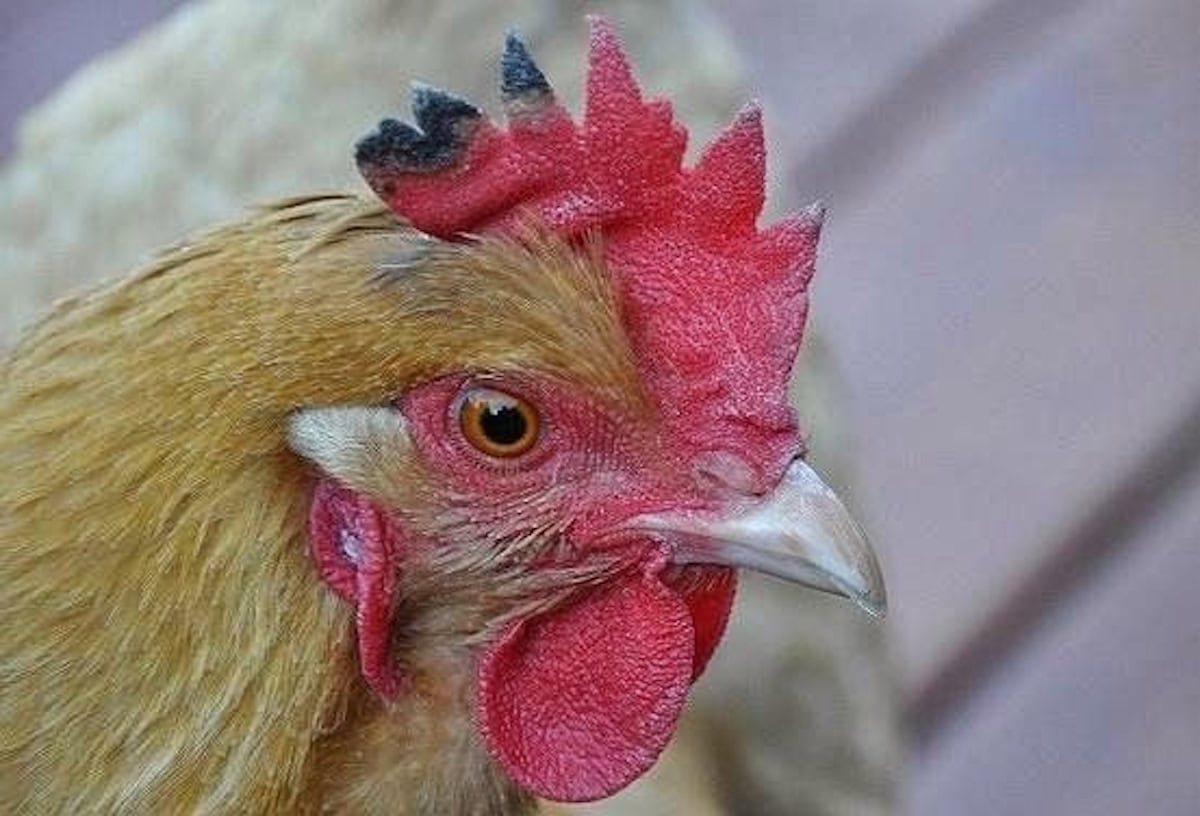
5) Use Flat Roosts
Roosts are a chicken coop basic, but they help keep them warm in winter too. Since heat rises, roosting up high is much warmer than being close to the cold ground. I even know folks who wrap their winter roosts in old cloth towels to offer extra insulation and comfort.
Flat roosts (such a 2×4″ board on its wide side) are generally more comfortable for chickens than round dowels or natural branches. In winter, flat roosts also help prevent frostbite! By keeping their feet flat, chickens can hunker down and keep their toes protected beneath their warm bodies and fluff. On the other hand, round roosts leaves their toes curled down and exposed. I’ve seen many chickens lose toes or even whole feet due to frostbite…
Also, there is warmth in numbers. Chickens snuggle together to stay more warm and cozy, so if you have a chicken that tends to sleep alone or in another location (such as in the nest box), move her to the roost with the others on frigid nights.

6) Winterize the Run
Winterizing your chicken run will encourage your flock to come out of the coop for some much-needed fresh air and sunshine on extra chilly days. (And to eat and drink, if that’s where you keep their food and water.)
In a similar fashion to the coop, you can use tarps, heavy-duty plastic sheeting, or sections of clear corrugated roofing material to cover or wrap the run area to offer added protection from rain, snow, and wind. I’ve seen folks create poly tunnels, hoop houses, or makeshift “greenhouses” for their chickens too!
Additionally, lay down thick straw over the frozen ground or snow, giving them a warmer place to comfortably walk around. Some chickens don’t mind tromping through the snow, but monitor their feet for signs of frostbite!
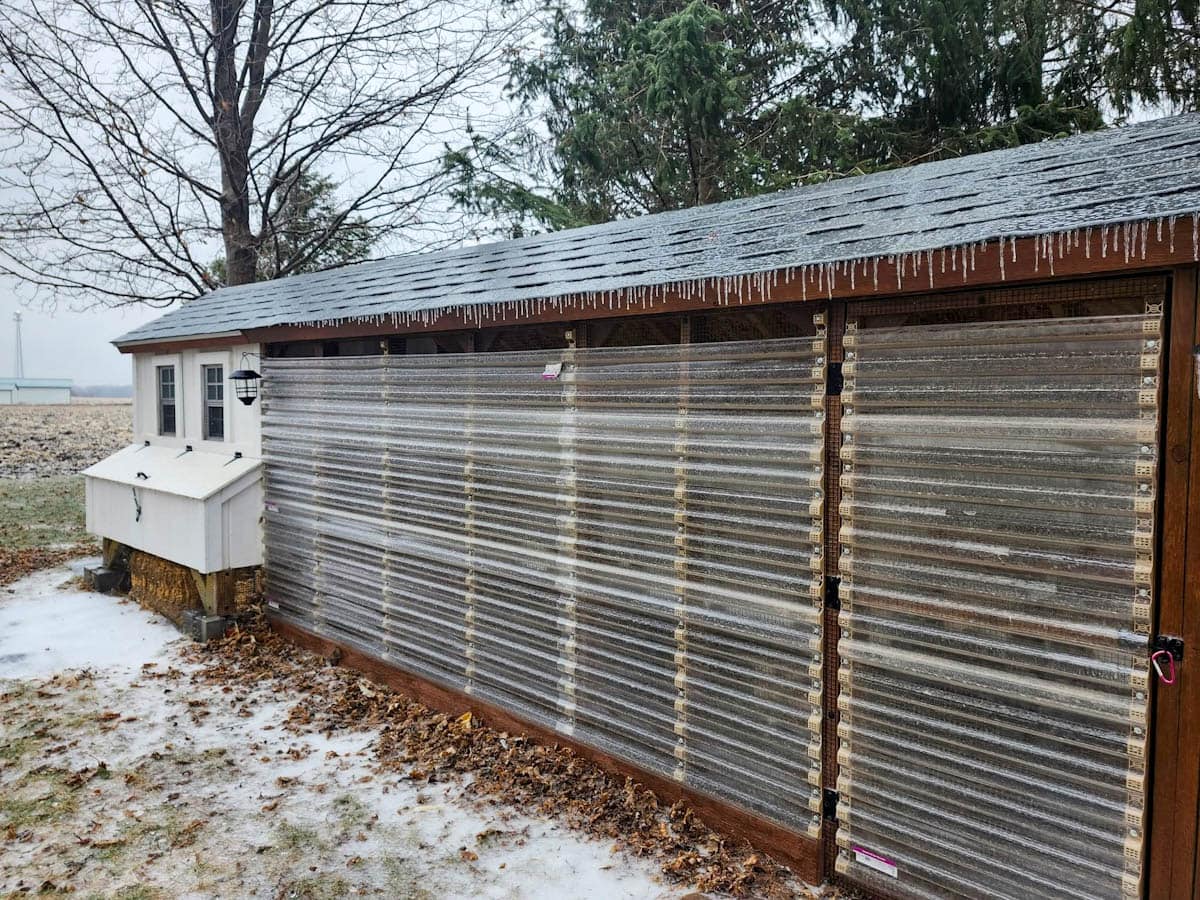

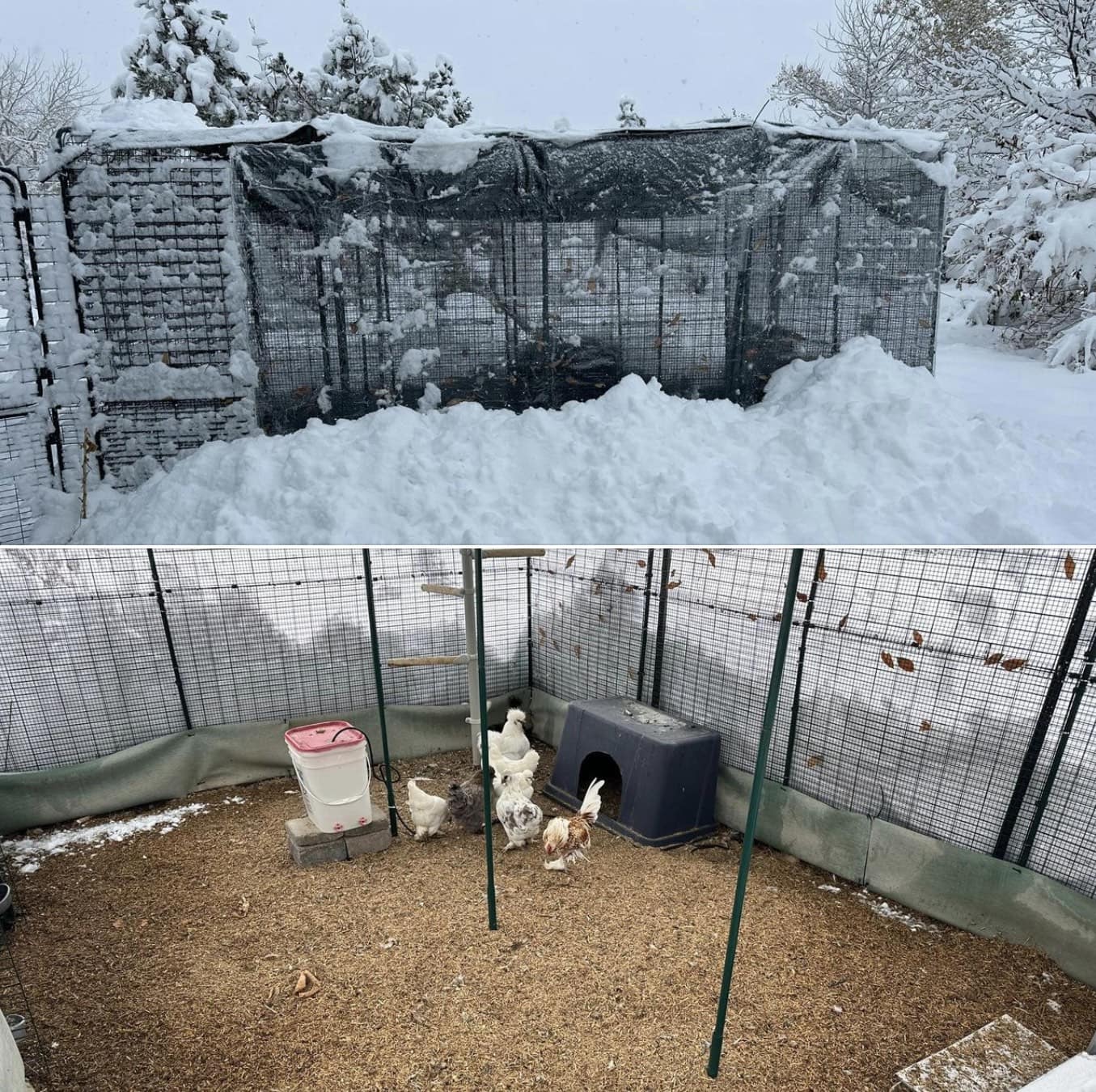

7) Warm Food, Carbs and Treats
Keeping your chickens well-fed during the winter also helps keep them warm! Even though they’re less active, chickens surprisingly consume more feed in the winter than they do in spring or summer. The simple process of consuming and digesting food helps generate internal heat, warming them from within. Plus if your flock normally free-ranges, reduced foraging in winter means they’ll be getting less calories from insects or plants.
As most chickens take a break from laying eggs in winter, their nutritional needs also shift slightly – demanding less protein for egg production and more carbohydrates for basic energy instead.
So, in addition to their regular feed, consider offering your flock warming treats (in moderation) such as cracked corn, scratch, DIY flock block, cooked rice, grits, corn, or warm oatmeal – perhaps topped with chopped fruit or sunflower seeds. You could also moisten their feed with warm water or offer fermented chicken feed for a nutritional boost.
Some folks choose to keep feed inside the coop during winter to encourage their birds to eat more, yet others prefer to keep it outside to force them to get outside for fresh air.
Finally, be sure to provide an additional source of grit if the ground is frozen or they cannot otherwise forage naturally! Grit is essential as it helps to properly break down food material in their crop.
RELATED: Don’t miss our complete list of chicken-safe treats (and toxic things to avoid) – or our easy flock block recipe, which is also a great boredom buster for winter!

8) Prevent Water from Freezing
As the temperatures drop below freezing, you need to find a way to prevent your chickens water from freezing too! Exactly how will vary depending on your climate, coop or run set up, and access to electricity. For instance, if it only freezes overnight in your area, you may be able to simply put out fresh water each morning.
Ways to keep chicken water from freezing:
- Manually change out the water as needed. This may mean bringing out fresh water each morning, or potentially a couple times per day – depending on your weather. Be sure to have two chicken waterers, bowls, or other containers available so you can simply swap out the frozen one for a fresh one.
- Keeping water in direct sun can help prevent it from freezing as readily.
- If electricity is available in your chicken coop or run, use a heated pet bowl, heated poultry waterer, or specialized heated base to set their water container on – made for this very situation.
- You could keep the water inside the coop, which should be several degrees warmer than ambient outdoor temperatures. However, some chicken keepers advise against putting water in the coop since it also adds undesirable moisture inside.
- Insulate the chickens water container such as with old wool caps, towels, or other materials. Chicken expert Lisa Steele from Fresh Eggs Daily shares a nifty trick to keep her chickens’ water from freezing using old insulated tires in this video.
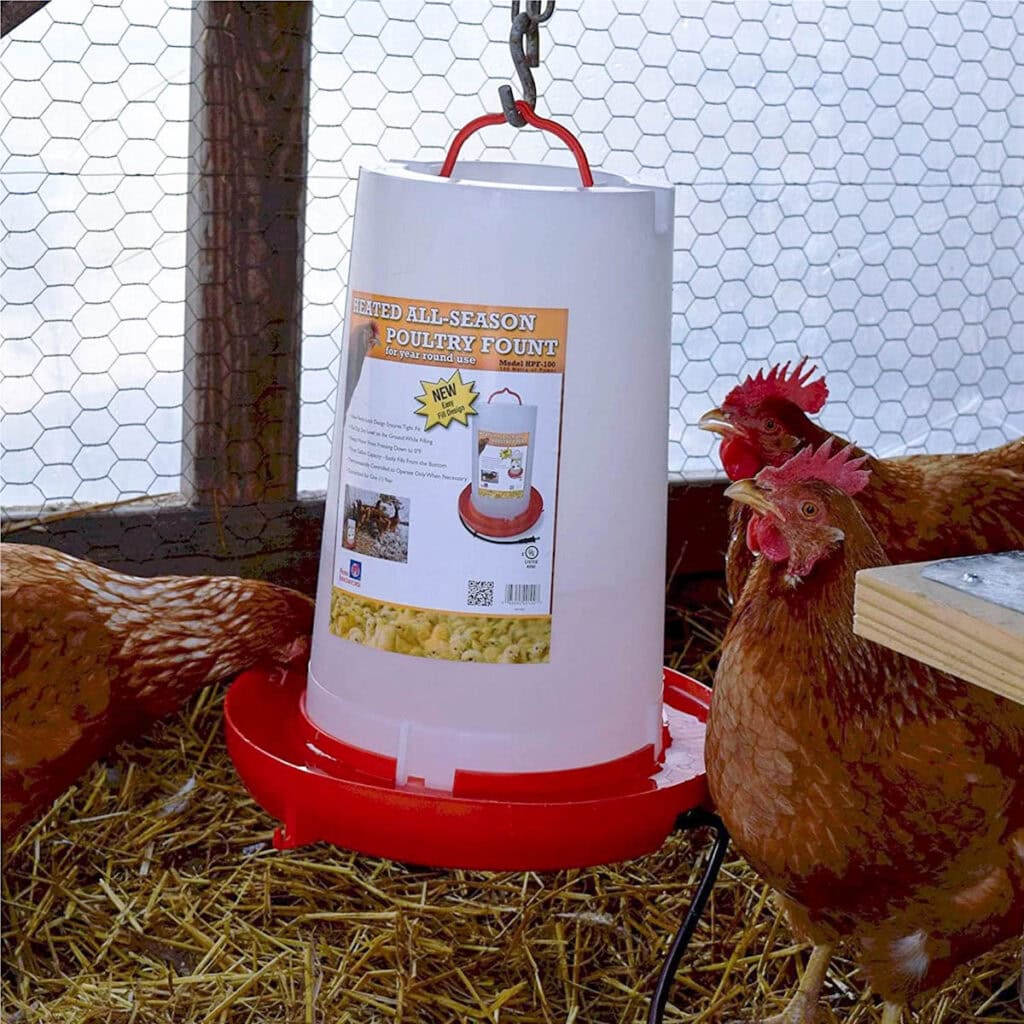
9) Deep Litter Method
You could also use the “deep litter method” in the coop to help keep your chickens warm in winter. Rather than regularly cleaning it out, continue to add more fresh bedding on top of soiled bedding. The deep litter provides insulation, and also naturally produces some heat thanks to the microbial activity within it – similar to a hot compost pile!
However, the deep litter method is only effective if managed properly. If not, it can also increase undesirable humidity and ammonia levels, causing more harm than good. See this guide to learn more about the deep litter method and best practices.

10) Electric Coop Heaters
Finally, you could install an electric coop heater to keep your chickens warm in winter, though it’s a somewhat controversial subject. Some cold-climate chicken keepers insist it isn’t necessary. It may also encourage the birds to stay indoors rather than getting fresh air outside, or prevent them from getting accustomed to the cold.
However, other chicken keepers routinely provide supplemental heat for their chickens in the winter – be it out of “necessity” and extreme cold, or simply because they feel sorry for the poor dears. Others only provide heat on occasion or extra-chilly nights.
The risk of fire is the largest concern with providing supplemental electric heat, so do your homework, heed safety precautions, and exercise good common sense if you decide to go this route! Traditional heat lamps pose the most fire risk, as they can easily topple over into bedding or other ignitable material. Yet there are many more modern, safer radiant-heat options available that pose less risk.
To heat or not to heat your chicken coop during winter is a personal decision.
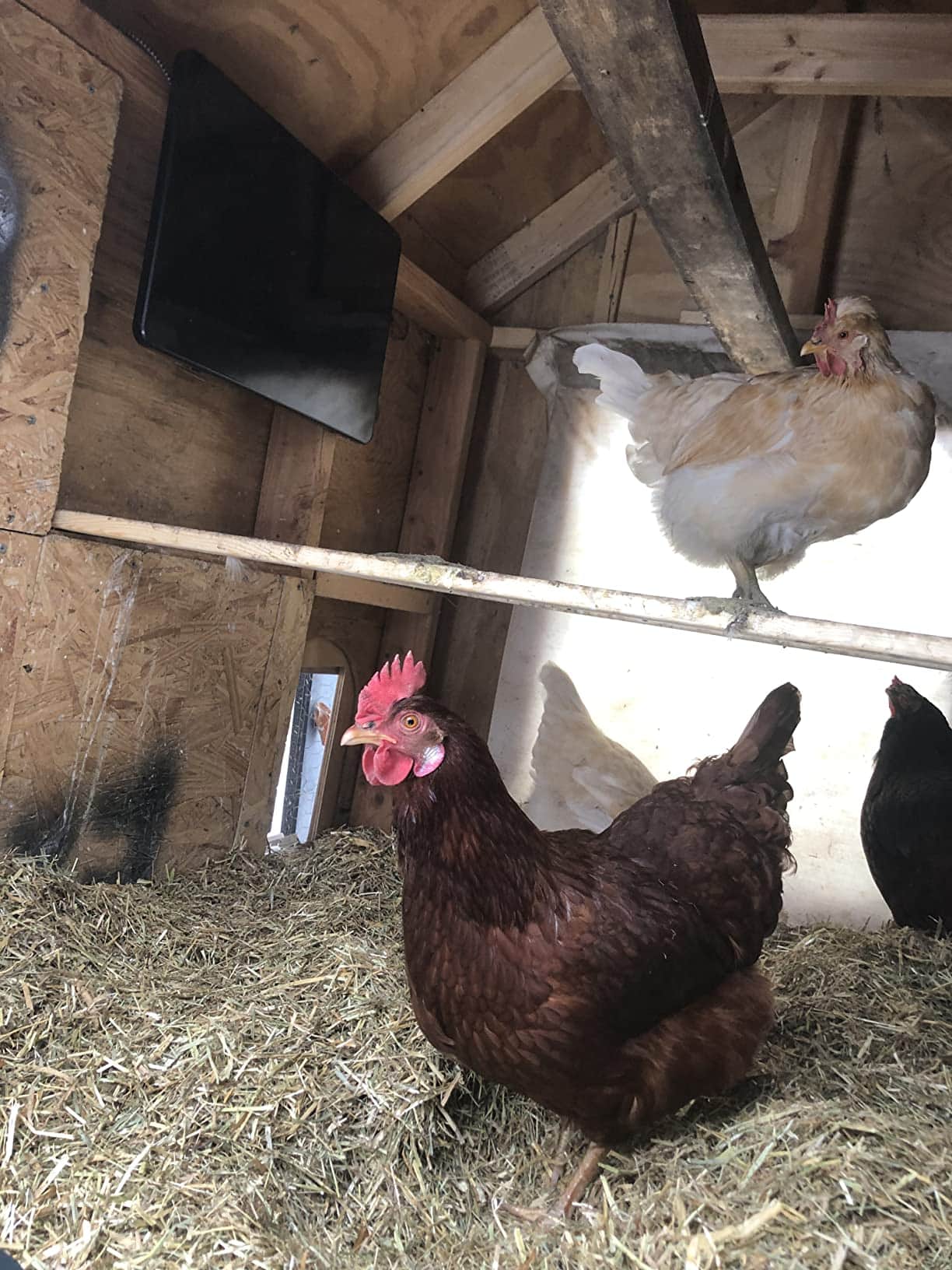
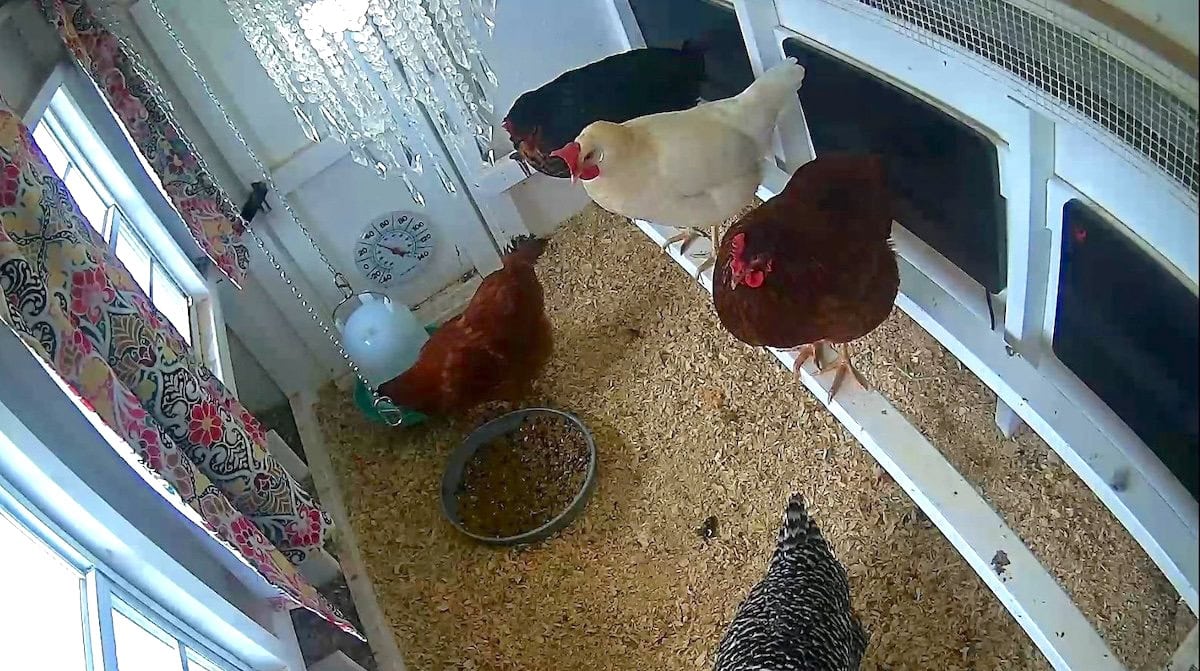
Tips for Molting During Winter
Most chickens go through their annual molt and lose feathers in the fall, but have hopefully grown fresh new fluffy feathers before deep winter hits. However, if you have molting chickens during very cold weather, there are a few things you can do to help them stay warm.
- Provide extra protein-rich foods to encourage fast feather growth.
- Create a “chicken sandwich” by tucking the less feathered birds between their biggest, fluffiest buddies on the roost at night.
- If necessary, carefully set up a safe heat source in the winter chicken coop – or even bring them indoors.
- As cute as it may seem, do NOT put “chicken sweaters” on them! The extra pressure against them is very uncomfortable and even painful while their new feathers are growing out.
For more tips, see our guide on caring for molting chickens.

And that concludes this lesson!
I hope you found this information to be useful, and learned something new to help your flock stay as warm and cozy as possible! Please feel free to ask questions, and pin or share this post.
If you’re a newer chicken parent, please pop over to our Beginner’s Guide on Raising Chickens for even more tips. Finally, when winter goes away and things start to heat up again, come back to learn 10 Ways to Keep Chickens Cool in Hot Summer Weather!
You may also like:
- 11 Easy DIY Chick Brooder Box Ideas with Photos
- When Do Chickens Start Laying Eggs? 5 Tell-Tale Signs It’s Soon!
- How to Store & Wash Fresh Eggs: Best Practices for Backyard Chicken Eggs
- How to Make a Chicken Dust Bath: Easy DIY Ideas









16 Comments
Trish
We live just south of The Adirondacks and our girls do ok in the cold-not happy exactly but they get through it. We’re about to have a very cold spell so I’m on watch. I give them warm oatmeal during the day, and cracked corn just before they roost. I haven’t used a poop board but I think we should. You just lay a board on the bedding and that’s that? If so, I think I was overthinking it! I fear I wasn’t cleaning the henhouse frequently enough andwe now have our first case (in 12 yrs. of chickens) of vent gleet right now which is a learning curve, and a gross operation of cleaning her butt. I hope it wasn’t due to too much poop in their house. All clean now.
She’s separated, inside, from the others but I’m concerned that she will get stressed from boredom. The crate she’s in is about 16″x30″ with a roost (and food/water) and she needs to be inside for at least a few more days. Other than yogurt, I don’t want to give her treats until we know the cause (her crop seems fine.) Any thoughts? Thanks for your good site! Sorry for the long post…
Aaron (Mr. DeannaCat)
Hi Trish, yes, a poop board is as simple as laying the board under their roost on top of the shavings. Makes cleanup very easy, especially if you line the board with vinyl or some material such as that. Separating your sick bird is a good idea although I am not sure of the best treatment for her, check out MyPetChicken to see more about vent gleet if you know for sure that is the issue. Hope that helps and good luck!
trish
thanks for confirming how easy a poop board is 🤔
I have another question from your good article-about fermenting feed.
I covered some layer pellets with water and when I checked it about 2 days later, it had a very thin ring, about halfway up the jar, goung around the petimeter, of something black…almost like in an ice core. I stirred it up before thinking it might be mold. But it makes me netvous to feed it to the chickens. I added water and I haven’t seen the black ring again. It is bubbly now.
What do you think?
thanks!
p.s. mypetchicken is great. It’s where I learned about vent gleet. Lacey is doing very well now and is outside again. keeping watch still though.
Aaron (Mr. DeannaCat)
Hi Trish, glad to hear your hen is doing better! Chickens should not eat any moldy food but I can’t honestly say what the black ring was? It could also be something in the feed? We have never had our fermented feed mold but that is not to say it can’t happen, you just have to use your best judgement. Hope that helps and good luck!
candy joubert
Great article and great information! It’s super, super, important to incorporate regular mite/lice prevention during cooped up winters (I’m in Pacific NW average snow 51″ per year, with 40+ bird mixed flock for the last 8+ years). The extra bedding material (or insulation) and the lack of sun and air flow and lack of plenty of natural dust bathing options mean mites and lice can propogate quickly. Depending on the type of mite, they can live on the bird or on the environment. When confined (whether ill, injured, or sheltering in winter), birds need regular dust bathing and extra help to control mites. I would note mice will need to be controlled as well – sigh!
EmiKate Webb
Thanks for the wonderful information! We are in the panhandle of Texas and just made it through this Arctic cold snap. We didn’t lose a single bird. It’s also our rookie year with chickens.
I learned some things we are doing right and wrong, but we will fix it! It’s because of people like you that help others succeed with their flock.
Thank you also for the good food ideas. I’m excited about making treats for them. Since the whole house is asleep I’ll wait until morning!
I’m looking forward to reading more from you!
Aaron (Mr. DeannaCat)
Thanks so much EmiKate, we’re glad you got through that crazy weather and thanks for keeping your birds in mind. Thanks for reading and we look forward to hearing more from you as well!
Grace Gidley
Thanks so much for this article, you had some good ideas I hadn’t thought of. This is my first time owning chickens and I have a question for you. What kind of plastic do you use to cover your chicken run? I used 4mm painter’s plastic and I’ve been having problems with it ripping when we have a really strong wind.
Aaron (Mr. DeannaCat)
Hello Grace, we cover a portion of the chicken run with corrugated plastic roofing that we got from the hardware store. We then drilled holes into the outer sections and connected the roofing to the run with wire or zip ties. It has worked great through the years. Thanks for reading and good luck!
Kym Cabral
Will chickens consume sunflower seeds (roasted and salted)?
Aaron (Mr. DeannaCat)
Hi Kym, it is best to avoid giving salty foods to your chickens. Black oil sunflower seeds are what we give our chickens as a treat and can be found at most feed stores. Good luck!
Christopher Sisk
New to chickens I’ve got ten leghorns and they just started layen 1 week ago. My daughter and I where so excited when we found they had laid eggs. We almost came to tears of joy. We live in kansas and been worried about the winter temps . But seems to be a waist of brain power after reading all the post and tips on the site. Found a lotta ideas to put to work. Thanks so much . Quick question, chickens panting is a sign of over heating . What’s the next sign to them having a stroke? God forbid
Aaron (Mr. DeannaCat)
Hello Christopher, congratulations on your flock of chickens. We have just the article for you; 10 Ways to Keep Chickens Cool During Hot Summer Weather or Heat Waves, let us know if you have any other questions and thanks for stopping by!
Bethany Hayes
Great tips and all totally right. My girls love warm oatmeal on super cold mornings. I like to toss in any fruit that might be going bad or some applesauce. I personally find taking care of chickens in the winter easier than worrying about them overheating in the summer when the temps near triple digits. Heat strokes are a bigger danger than the cold temps!
Lauren
I’ve had backyard chickens in the Midwest for a few years now and still learned so much from this post! How would you recommend carefully and safely maintaining a deep litter overwinter?
DeannaCat
Hi Lauren – That is so great to hear, and I’m glad you picked up a few new tips! We don’t usually use the deep litter method, so I will refer you to an expert – the Chicken Chick. See her article about it here. We usually keep a “poop board” under their roost, which is a piece of plywood covered in vinyl/laminate for easy cleaning, and we scoop that up daily. It sits on top of their deeper layer of pine shavings bedding, positioned below their roost to catch nighttime droppings. I hope that helps!